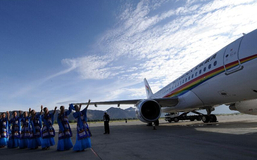The eight "Route Signs" in Tibet (I)
"Roads are full of rocks, no places for people and horses”, this was a real description about Tibetan transportation in the past. In the last 50 years, the state has been urging a lot of effort in constructing Tibetan transportation, therein the kind of saying such as “it is difficult to enter Tibet” has become history.
Nowadays, when leafing through the China’s Transportation Atlas, you can find a modernized transportation system which is composed of many transportation modes such as railways, highways and airlines giving the impression of a "silver dragon" flying in throughout the depths of the Qinghai-Tibetan Plateau’s mountains and ravines.
Route Sign 1: Tibetan civil aviation has been opened
The average altitude in Tibet is over 4,000 meters, with thin air and complex climate, therefore, Tibet has been considered by the international airline circle as a “forbidden zone”. After 10 years of repeated experiments, on the first day of March 1965, the IR-18 Airplane took off from Beijing and arrived at the Damxung Airport in Tibet the next day, and thereby the Tibetan civil aviation was hence officially opened.
So far, there has been built a five-airport network in Tibet which is centered at the Gonggar Airport in Lhasa with the four other branch-routes located in Bangda of Qamdo, Mainling of Nyingchi, Kunsha of Ngari and Heping Airport in Shigatse, thereby opening 58 domestic and international airway routes to 29 different cities.
Route Sign 2: Qinghai-Tibet Railway has been opened to traffic
The American train traveler Paul Taylor said that: “With the existence of the Kunlun Mountains, railways will not be able to reach Lhasa ever.” On the July 1st 2006, the 1,956-kilometter Qinghai-Tibet Railway was opened, breaking this precipitate assertion.
Nowadays, the Qinghai-Tibet Railway has been safely in use for more than 3,000 days, accumulating over 95 mln person-times and over 400 mln tons of goods, thereby pushing the annual average economic growth of Qinghai and Tibet to over 10%. Following the economic and social growth of Sichuan and Tibet, the second sky train entering Tibet – the Sichuan-Tibet Railway is now also under construction.
Route Sign 3: The Lhasa- Konggar Airport Highway has been completed
On the 7th of July 2011, the first highway in Tibet connecting Lhasa with the Gonggar Airport was officially opened, marking the beginning of the highway age in theTibet and realizing the breakthrough of zero high-quality highways.
The Ganggar Airport Highway is fully invested by the government by an amount of 1,59 billion yuan. It is a 37.8-kilometter long highway, being constructed under the first level highway technical standards with two lanes on each side. The Ganggar Airport Highway makes the duration traveling from Lhasa downtown to the Ganggar Airport shortened down to one half of an hour.
Route Sign 4: The MetokMetok road has been opened to traffic
On the 31st of October 2013, the Metok public road which is about 117-kilometter long with a total investment amount of 1,600,000,000 RMB was officially opened, therein making Metok no longer the last county that was not opened to the public roads. The Metok public road opening to traffic has gradually led to the withdrawal of the local "monkey' roads, horse roads as well as the over-head-cable bridges, “150 yuan for a chicken, 25 yuanfor a shredded potato dish” has gradually fallen down to a normal price. The so-called “plateau isolated island” in the past has also taken its chance to exit its “boudoir”. In 2014, Metok received almost 100,000 visitors, reaching double growth year-on-year.
Your Comment
Name E-mailRelated News
-
;
-
-

-
Lhasa: the 2016 spring festival transportation kicked off
On January 24th, 2016 the national Spring Festival transportation kicked off.
-
-
-

-
1st Day for Spring Festival transportation on Qinghai-Tibet Railwa
On Jan. 24, the Lhasa railway station square is full of passengers; the ticket office hall is filled with crowds queuing in line waiting to collect their tickets.
-
-
-

-
Development of transportation in Tibet over past 5 decades
Photo taken on Aug. 29, 2014 shows the Lhasa-Gonggar Airport highway, southwest China's Tibet Autonomous Region.
-
Based in Lhasa, Tibet Vista is a Tibet travel agency that specialized in Tibet permit, and Tibet tours for both private and group travelers at a local price!
•4 Days Lhasa City Group Tour from USD 460 •8 Days Everest Base Camp Group Tour from USD 850 •15 Days Mt.Kailash Group Tour from USD 1780 •2016 Tibet Train Tours from Beijing, Shanghai, Chengdu, Xining,etc










